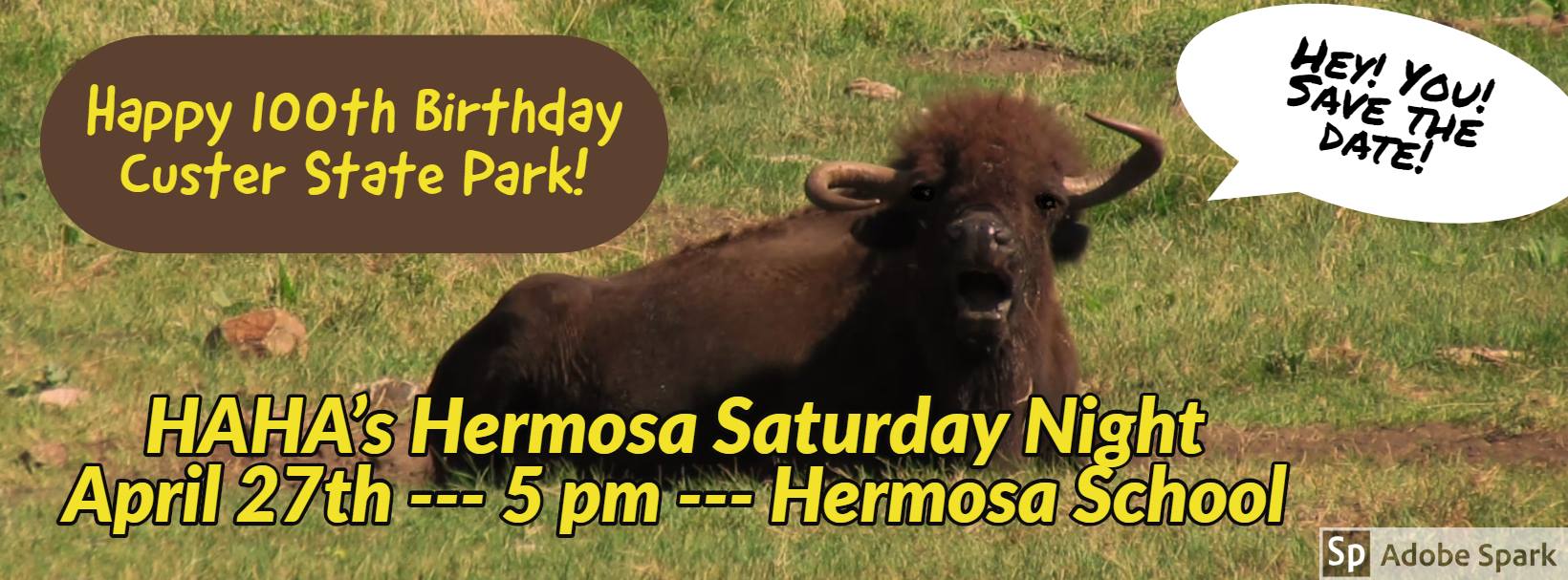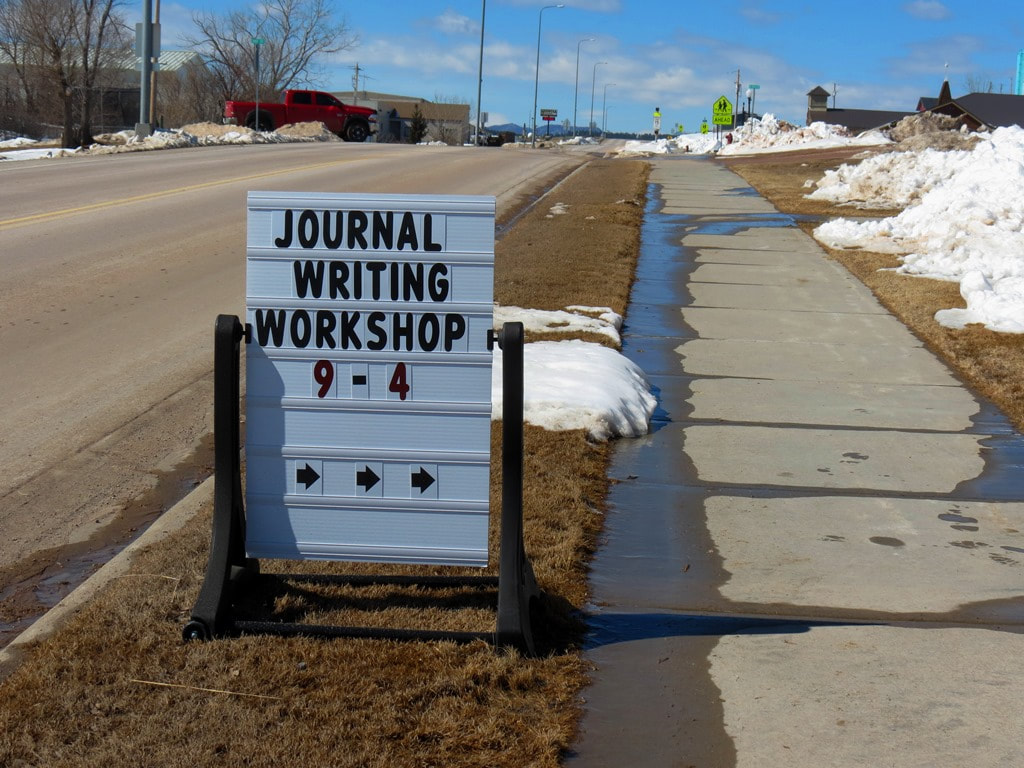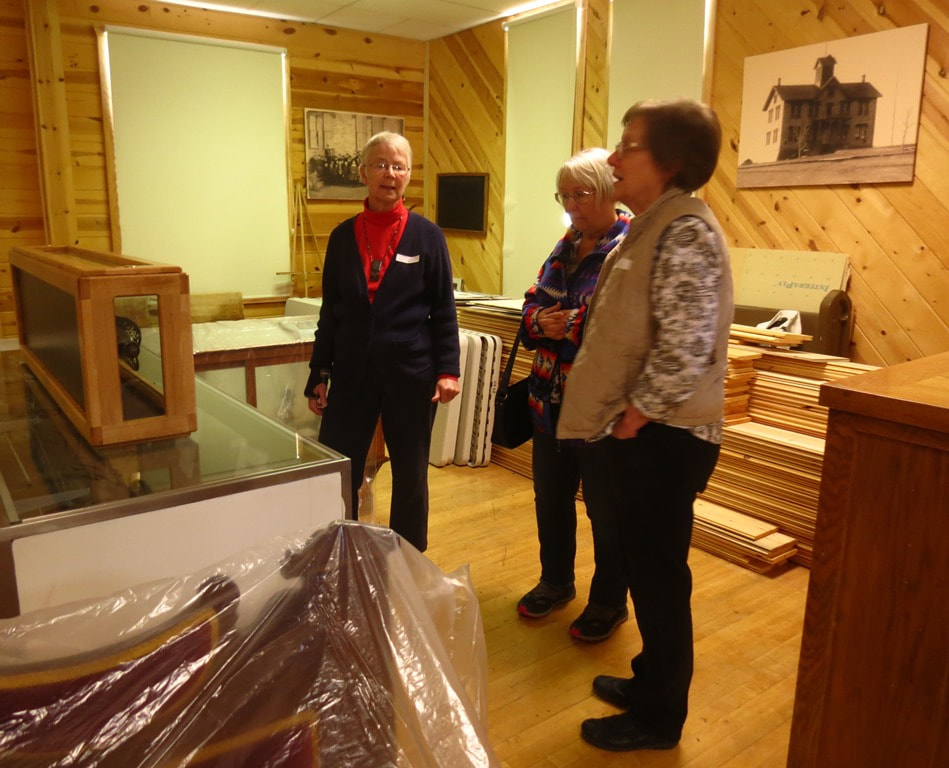Hermosa Arts & History Association
|
This is a reminder that the April HAHA meeting will be Monday, April 8, 2019; meeting starts at 6:30 pm.
Meeting place is supposed to be at the museum building in Hermosa. If the weather is too cold, the meeting will be at the Hermosa Branch Library—-in [lower level] meeting room. Hope to see you there. --- Donna (secretary for HAHA) ++--++--++ All are welcome to attend the monthly HAHA meetings-- we'd love to have you join us: we promote the local history and arts and educate the community, and we have fun doing so-- it's not a coincidence that our acronym is HAHA. This month we will be finalizing plans for our April 27th HAHA "Hermosa Saturday Night" fundraiser to be held at the Hermosa School. This year's program celebrates the 100th Anniversary of Custer State Park. # # #
1 Comment
Linda Hasselstrom says--
It seems so appropriate that Candice Leigh, HAHA volunteer, accessioned for the HAHA collection this quilt made by a number of Hermosa women in Ladies Aid and purchased at an auction by my mother, Mildred Hasselstrom. During the auction my mother got so excited to win that she bid against herself, raising the price. Because the money was going to a good cause, the auctioneer just smiled and kept going. If anyone knows the history of who made this quilt, please let us know at HAHA. # # # I grew up in the community where I still live, so when we leave home, I am likely to see the sagging barns and empty storefronts as they once were. Then I blink, and a couple of generations pass. Because the older pictures are still in my mind, I find it easy to visualize this drive as I would have seen it a few decades ago. Gus Maus is planting windbreak trees along his entrance road, trees that still catch the snow and keep the road relatively clear even in a high wind. Like my dad, he planted dozens of trees, taking time from his ranch chores to look to the future, sheltering generations he would never know. Only corrals are left at the next place, though they’re kept in good repair. When the kids sold it to that corporate ranch, hired hands tore down the house, the barn, the machine shed. They had no need to rent them out or use it for hired help since they only use the corrals only once or twice a year. They’ve put in a good chute so they can ship the calves from here. At the next place, I can almost see Pratt’s milk cows walk out of the barn, down the draw, and into the dark underpass of the highway, emerging on the other side without so much as flicking an ear at the traffic. Walking slowly, their great white bags swinging, they spread out over the pasture like a river delta, grazing slowly up the hill. If we are driving toward home at dusk, I visualize the cows begin to turn as they graze, and begin to pace deliberately back down the hill and under the highway to line up in front of the barn. Archie—that was his name! (I’ve only remembered because I was remembering the cows and their stately march)—would be waiting to wipe down their udders. Then he and whatever hired hand was working there that year would perch on low stools and begin the slow job of milking a couple of dozen cows by hand. Now the big old barn that once gleamed white, repainted every year or two, is a dingy gray, with shingles missing, slats kicked out of the sides. The Hansen house burned while it was rented out, I think, after the old folks died. Just as well; the absent son rented it to people who threw beer cans in the ditches as they roared along the county roads. The county now piles gravel where the house stood, but when I drive by, I can see it still: two stories, with white net curtains in all the windows though the paint was gray and chipping. I can almost see the old woman looking out the window to see who might be driving up for a visit. The trees old Joe Burns planted as a shelter for his missus thrive still; they’ve both been gone for decades, and no trace remains of the buildings. A long metal storage shed for feed stands where the Briscoe house used to be. That’s another ranch dissolved into a bigger holding, with hired hands who live in trailers for a season or two. No need for the old houses. The corporate owners buy calves in the spring, feed them for six months and sell them, so they don’t need winter shelter. Most of the hired hands drift on come winter, since they have no insurance, and no guarantee they’ll have a job next year. There’s the Elm Creek School: windows and doors gone, holes in the roof. Half the white-haired old folks in the county went to grade school there. Consolidation, don’t you know. Now the kids ride the bus, or their parents drive them miles to school in town. In town they aren’t the sons and daughters of respected ranchers, just shabby teens with western shirts, scuffed boots and calloused hands. Johnsons. I hear the folks moved back to the old house they built when they married, let the kids have the big new one. I can remember how they worked together on that little house: he cut the studs and she nailed them up. They call it cozy instead of small, and are happier than they were behind the wide picture windows of the new place. My uncle Bud Hey stands in front of his filling station in Hermosa—recognizable today by the GARAGE sign--wiping his hands on a greasy rag as he asks what the HELL you want. People used to say that when he was banging around under someone’s truck, they could see the swear words boil out of the building in a black cloud that scorched the air. In the only photograph I have seen of his business, he’s not really visible. In November of 1954, a ruptured oil line forced an Army Hiller 12 E helicopter from Ellsworth Air Force Base into an emergency landing in a hayfield beside the Custer County Fairgrounds south of town. Bud’s son, my cousin Roy Hey, remembers that once the ‘copter, a three-place model used for observation, was repaired, it was brought to Bud’s Mobil station and filled with “Mobile Special” gas so it could continue its journey. Bud is somewhere behind the ‘copter, probably filling the gas tank, while bystanders watch. Roy visited not long ago, and he and I strolled around town, feeding each other’s memories and smiling a lot. Passing Hermosa, I see a cloud of dust rocketing up the hill toward the ranch where my uncle Harold Hasselstrom lived most of his life. His wife, my Aunt Josephine, never observed a speed limit in her life. She was always in a hurry, but she never ran over anyone, and she was usually taking a pie to some family who had suffered a death, or rushing to a nearby town to help serve a community dinner. She poured her energy and her money into this community every year she lived here. And there, across the tracks, is the Bill Snable house. I never knew Bill; he was gone before I arrived here, but I’ve heard stories about him all my life. His photograph appears in the monumental history of our county, OUR YESTERDAYS (920 pages), so I can even picture his reluctant smile.
He’d lived in Chicago, where he drove a jitney bus for the city, and was a mechanic. By the time he came to the neighborhood in 1912, he’d served in the U.S. Army during the Spanish American war, and was stationed in Florida. His marriage had vanished, though apparently a stepdaughter survived him. For a while, he worked for Charles Upham on his ranch near town, but he filed on a homestead in what was then the Urban community. In his spare time, he collected stones from his own land and fashioned them into a sturdy house. In 1917, he moved to his ranch, ran a few cattle and, according to the history book, farmed a little; it’s hard for me to imagine how, considering the abundance of rocks. In 1946, he moved to the State Soldiers Home in Hot Springs for two years, making occasional trips back to his place. In the spring of 1948, he sold his ranch to Hasselstrom Brothers. He died in 1950 in Battle Mountain Sanitarium at Hot Springs. From my dining room window, I look at Bill’s house every day. Nothing remains on the broad plain but the house, standing like a sentry over the land that must have meant freedom to Bill. How did this man, who’d lived in Chicago, decide that he wanted to live on the South Dakota prairie? I can’t imagine that we will ever know. But I have a photograph of this memory, framed to keep it safe. (Some names have been changed and locations shifted to protect the privacy or memories of me or others.) # # # HAHA presents our annual Hermosa Saturday Night fundraiser program.
Saturday, April 27th --- 5 pm --- at the Hermosa School This year we celebrate our 100-year-old neighbor, Custer State Park. Speakers Craig Pugsley and Dick Miller will tell stories about their years working at the park. History! Excitement! Humor! Sally Svenson, local musician and long-time Park employee, will debut a couple songs she has written for Custer State Park's 100th anniversary. Enjoy a tasty supper for a free-will donation. Sloppy Joes, chips, and HAHA's famous brownies and desserts. Our fundraiser this year is called HAHA's Lucky Number Raffle-- donate and you may win cash prizes. We will also have some Hermosa memorabilia for silent auction. # # # Leta Campbell, treasurer of HAHA, presents a microwave oven to Roberta Upton, Hermosa librarian, on Friday, March 22nd.
The microwave, which will be used in the meeting room in the basement of the library building, is part of the Hermosa Arts and History Association's Thank You to the Hermosa Library for co-sponsoring the Journal Writing Workshop recently conducted by local author Linda M. Hasselstrom. The microwave was funded by donations made expressly for this thank you gift. # # # We had a wonderful HAHA Journal Writing workshop on Saturday, March 16th. A huge THANK YOU to Linda M. Hasselstrom for teaching this free class.
16 women attended and learned much from Linda's suggestions about using a journal, 2-minute writing exercises in class, Linda's stories about her writing life, and some thoughtful group discussion. Women went home inspired to write in their journals! During the lunch break everyone stepped outside to enjoy the warmth of the sun and the fresh, blue sky. A few of us toured the HAHA Museum briefly, though many exhibits are covered against dust until the next Museum Open House. (see photo below) Our hero of the day was Bert, from the Hermosa Library, who supplied coffee and snacks for our breaks-- brownies, lemon bars, fruit platter, vegetables and dip -- YUM! I should have taken a photo because the food was as beautiful as it was delicious. Send HAHA a Facebook message or send an email to Linda at [email protected] if you want to be put on an email list to be notified of any class in the future. Learn more about Linda at her Facebook page Linda M. Hasselstrom's Windbreak House or at her website www.windbreakhouse.com # # # Be sure to bring along a journal to this free workshop.
If you don't already have one, you can find some lovely ones at Mitzi's Booksin Rapid City. Tell them Linda M. Hasselstrom sent you! *~*~*~*~* Hermosa Arts & History Association Presents a journal-writing workshop with local author Linda M. Hasselstrom Your Journal Can Save Your Life Saturday, March 16 9 a.m. to 4 p.m. Free to the public (must be at least 15 years old) Location: Hermosa Library Lower level meeting room ________________________________________ Please register in advance, to help us determine how many supplies we will need. However, walk-ins will be welcome at 8:45 a.m. on March 16th. To register, contact any of these: Hermosa Arts & History Association [email protected] or through Facebook messenger www.facebook.com/HermosaHistory/ Hermosa Library [email protected] or sign up at the library Linda M. Hasselstrom [email protected] or through Facebook messenger www.facebook.com/WindbreakHouse/ Please give us your name, email address, mailing address and phone number. *~*~*~*~* “Eighty percent of success is showing up.” ---Woody Allen *~*~*~*~* Workshop Schedule: 9:00 a.m. -- Introductions 10:30 -- coffee and snacks 12 noon to 1 p.m. -- lunch break 2:30 -- coffee and snacks 4:00 -- Assignment for continued journal entries Bring with you: -- a journal of your choosing & a pen -- your lunch (snacks will be available) *~*~*~*~* “I am the Writer of my own story.” *~*~*~*~* Linda M. Hasselstrom is an award-winning author and poet who has kept journals all her life. She has taught writing since the 1960s, and established Windbreak House Writing Retreats in 1996, on her family ranch south of Hermosa. www.WindbreakHouse.com *~*~*~*~* The workshop is FREE but please show your appreciation by contributing to the sponsors as you are able; donation box will be available. Hermosa Arts & History Association PO Box 175, Hermosa SD 57744 www.HermosaHistory.org Hermosa Public Library 234 Main Street, Hermosa SD 57744 www.CusterCountyLibrary.org/Hermosa # # # HAHA Member Meeting
Monday, March 11th -- 6:30 pm Hermosa Town Office/Library lower-level meeting room. On the agenda: Final planning for "Hermosa Saturday Night," our April fundraiser. This year we are honoring Custer State Park for being our good neighbor for 100 years. All are welcome to attend the member meeting. We'd love to have you help us with this fun event! # # # The February 2019 meeting of Hermosa Arts and History Assn. will take place tomorrow, Monday, February 11, 2019, at 6:30 pm in the LL meeting room, Hermosa Branch Library, Main St., Hermosa.
Donna Evjen, Secretary # # # HAHA has big plans for 2019.
At our first member meeting of the year we will recap what we did in 2018 and create a schedule of events and a prioritized list of building renovations to be done in the coming year. Watch this Facebook page or check out the website to read all about it. www.HermosaHistory.org The annual HAHA Member Meeting and Potluck is Saturday, January 12th. Potluck meal at 11 am, meeting to follow. We'd love to have you join us for fun, fellowship, and promoting our local history and the arts in the Hermosa community & eastern Custer County. If you're not on our email list and haven't received a note about this meeting's location and you want to attend, use Facebook messenger, or send an email to [email protected] and we'll give you directions. # # # |
"The Pilot"The Pilot was Hermosa's first newspaper, thriving one year after Hermosa became a town. (John Stanley, editor.) Archives
May 2019
Categories |
Proudly powered by Weebly










 RSS Feed
RSS Feed